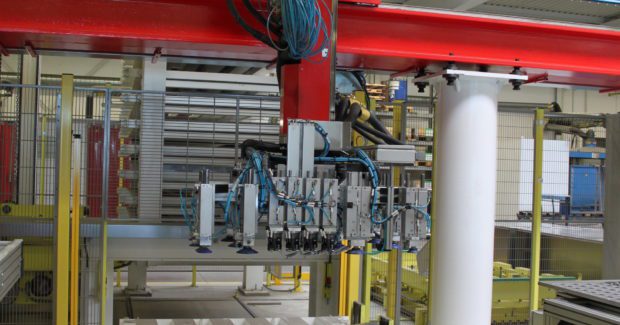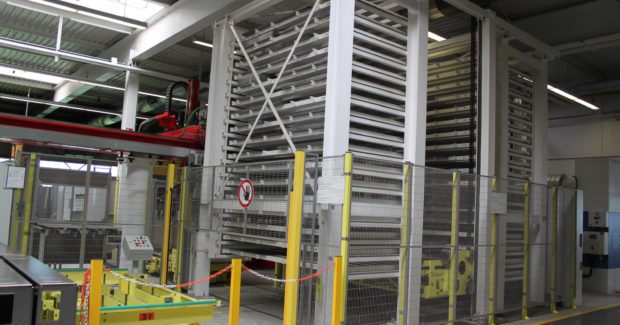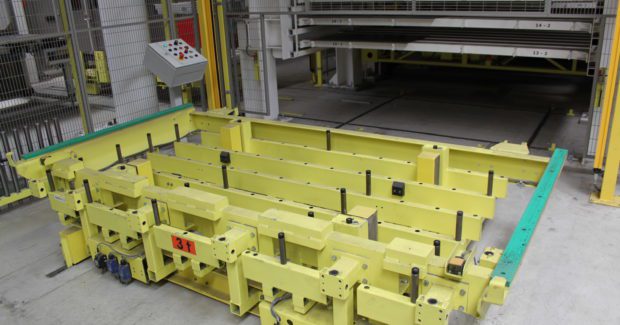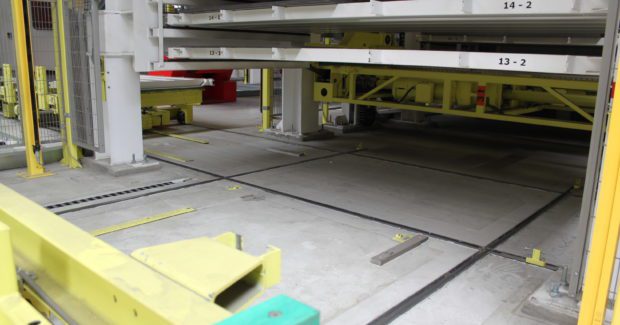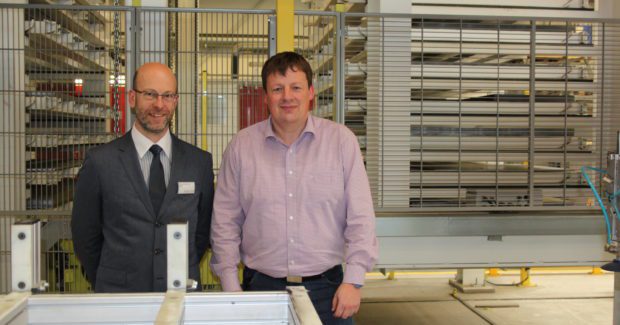How to Automate a Batch Size of One
This shop discovered how to use a high degree of automation integrated with a sheet metal storage system to quickly turn around a wide variety of power distribution systems for the electrical trade and switchgear production.
Posted: October 11, 2016
Processing about 9,500 tons of steel sheets a year that come in a wide range of material qualities with various black and galvanized surfaces that are used as coils or plates for power distribution systems is a complicated task for Striebel & John GmbH & Co. KG (Sasbach, Germany). Founded in 1958 by Franz Striebel, this shop has evolved into a specialist that employs about 450 people to develop and build mounting boxes and power distribution systems for the electrical trade and switchgear production.
The shop manufactures consumer units, compact distribution boards, and wall mounting, meter, floor standing and switchgear cabinets that cover every conceivable application in both commercial and industrial environments. The company’s electrical system planners use their own StriePlan e-design software suite to integrate component functionality with customer requirements, then centrally coordinate the production of all of these different modular systems while they are being built on the shop floor. This communication enables a quick in-house production turnaround of mounting boxes, cabinets, and accessories as needed to the fitters and system builders on the floor who are matching various internal configurations on each job to customer requirements. A high level of in-house production effectively regulates the required output with a corresponding flexibility that comes by using the appropriate machinery with indispensable expertise.
To maintain profitability in this rapid-response production environment, consistent automation is used from the sheet metal storage system to the final production of mounting boxes. “At our sheet metal parts production and assembly lines we have to manage four series of products, namely: compact distribution boards, meter and other cabinets, and the TwinLine and TriLine series,” explains Roland Schnurr, the head of production at Striebel & John. “Since our customers in the wholesale electrical systems and switchgear production sectors no longer manage storage systems, we are forced to provide highly flexible, job-controlled manufacturing of batch sizes from a single lot. This is economically viable only with a certain, very high yet practical degree of automation. For this reason, we’ve extended automation to much of our preproduction of parts, such as punching, bending, and shaping, and in the final production involving welding and bonding.”
That’s not all. “We also apply powder coatings in the standard colors on site, whereas special colors are handled by external providers,” adds Schnurr. “Beyond the variations in product size, width and depth, and technical function, the types of interior designs that are required also distinguish the different regions of the customers. The variety of interior finishes makes assembly primarily manual work.”
For example, when a recently ordered modular system needed new components, the following specifications were formulated for part production: delivery time 48 hours, a batch size of one throughout sheet metal parts production and assembly welding, inline setups, continuous component provision, production stock from ongoing orders for no-break final production through welding, and access to all pre-produced and order-relevant components. These last components are standardized rear panels in a range of sizes that are welded to other parts to form complete mounting boxes or cabinets in final production using an automated system that consists of welding and spot welding robots with glue application and a two-changeover table served by a gantry robot system and a Unitower B 3.0 automatic sheet metal storage system from KASTO Maschinenbau GmbH & Co. KG (Achern-Gamshurst, Germany).
To make batch sizes of one a reality when producing so many varieties of mounting boxes, the task of the automatic inline storage system is to supply the welding cell with the various rear panels as required. This means the inline system must function as a buffer and interim storage system that can be supplied externally as well as inline with parts that are needed either immediately or at a later time. To do this, the sheet metal storage system presents a total of 35 pallet storage locations arranged in two blocks that provide the required quantities of the various rear panel geometries. These pallets are designed for payloads up to 2,500 mm long, 1,545 mm wide, 130 mm high and 3 tons in weight. The operating gantry crane traverses between the two shelf blocks and handles all of the storage and removal operations.
Outside of the cell area, downstream of the transverse storage station, the crane utilizes the carriage for the removal and return storage systems. Inside the welding/gantry robot cell, it utilizes the carriage for the longitudinal transfer system. The pallet changeover time from the transfer station to the gantry robot system, starting from the carriage’s parked position, is only 135 seconds. This cycle time includes the carriage’s traverse into the shelf block, the return of the pallet that is no longer needed, the retrieval of the requested pallet, and finally, the traverse to the position for transfer to the gantry robot system and automatic loading on the changeover table. This 135-second cycle runs parallel to the welding cycles of the robots. To minimize storage and removal times, the operating gantry crane traverses in the hoist at speeds up to 16 m/min and the push/pull mechanism for the pallets up to 20 m/min.
“We’re working here with two pallet carriages that operate independently of each other,” explains Martin Stöckle, a sales leader from KASTO, as he describes the particular features of this custom storage and material flow solution. “The storage/removal carriage for transverse station one features a hydraulic lifter with pistons for the crane or side loader provision and removal of the pallets, as well as an optical contour monitor. The carriage for transporting the sheet metal into the transfer station for the gantry robot system also has an optical contour monitor and includes a fanning magnet to reliably separate the stacked metal sheets. The controller for the Unitower storage system and the two carriages is responsible for all storage and material flow operations. It interfaces with the controller for the gantry and welding robot cells. In practice, it’s possible to switch in auto or manual mode. This means the system is available at all times for the constant supply of material.”
The success of this automated system has produced 50 percent growth in capacity with 40 percent fewer personnel hours than the costly manual operations that were used earlier. In fact, the system works so well that the worker at the setup station now only needs to insert the side panel elements, secure them in the clamps and then release the auto mode initiation. “The gantry robot retrieves a rear panel on the carriage in the transfer station and places it precisely in the receivers for the spot welding operations and glue application,” notes Schnurr. The robot system tools itself according to the type of mounting box being built and signals to the storage system controller which of the stored rear panel variants must be provided next. From that point everything proceeds automatically. After the boxes are welded and glued, they are placed on a pallet by the robot. The operator removes only the pallet loaded with cabinets.
“Aided by the robot system and the automated material supply, this growth in capacity allowed us to easily master sudden increases following the start-up phase of our the product line without additional personnel. This has had a very encouraging effect on our ability to deliver in time,” smiled Schnurr. “At the same time, we can now flexibly provide our customers with a batch size of one in a very short time.”
KASTO, Inc., 3002 Venture Court, Export, PA 15632-8949, 724-325-5600, www.kasto.com.



